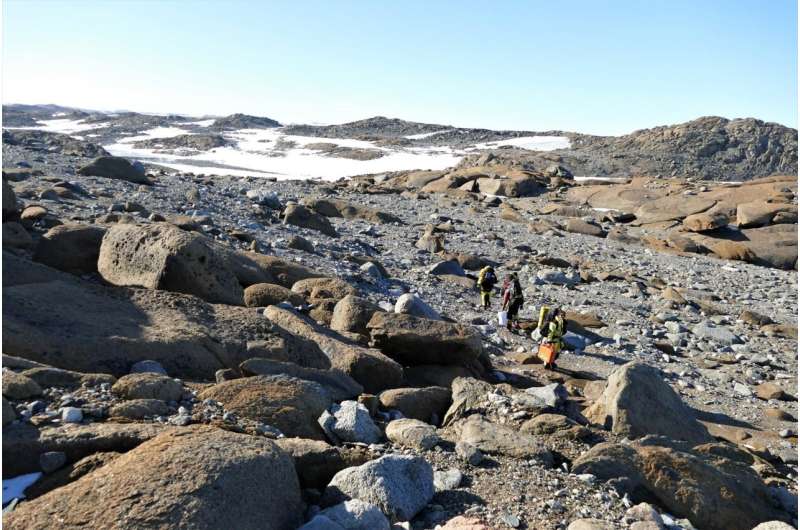This article has been reviewed according to Science X's editorial process and policies. Editors have highlighted the following attributes while ensuring the content's credibility:
fact-checked
peer-reviewed publication
trusted source
proofread
Climate change is wiping out rare bacteria in a 'greening' Antarctica

Plenty is known about the existential threat of climate change to plants and animals. But by comparison, we know very little about how microorganisms will be affected by climate change.
And until recently, our knowledge of microorganisms in Antarctica was non-existent, where the effects of climate change are arguably the most profound. But a paper published recently in Conservation Biology provides a new snapshot of the changing composition of microorganisms in Antarctica.
Professor Belinda Ferrari with UNSW Sydney's School of Biotech & Biomolecular Science and colleagues visited Casey Station in Eastern Antarctica in 2019 to see whether projections made on soils sampled 14 years earlier about the disappearance of microbes thriving solely on chemicals in the atmosphere were correct.
They were saddened to find that they were.
"These bacteria are really rare," says Prof. Ferrari.
"They're the ones that live on trace gases in the atmosphere, but in Antarctica they're actually the dominant microbes."
The modeling on soils sampled 14 years earlier used a statistical method never before used with microbes, called Gradient Forest, that's usually used to project animal and plant species' survival into the future based on changing environmental parameters.
The model suggested that as the Antarctic desert gets less arid and becomes wetter, the changing conditions favor photosynthetic microbes, or phototrophs—the ones that convert light into energy in the same way plants do—over trace gas chemosynthetic bacteria, which feed on low levels of hydrogen gas present in the atmosphere. And this explains why the chemosynthetic microbes had diminished in numbers.
"Because there are no vascular plants in this region of eastern Antarctica, microbes are really important for primary production," Prof. Ferrari says, alluding to the process of creating the organic molecules that are crucial to the food web and the basis of almost all life on Earth.
"And so what we predicted will happen is that there will be more phototrophs like algae and cyanobacteria and this will result in a greening effect in Antarctica—that reflects a warming climate."
Possible effects of this shift in microbe population could have a knock-on effect on the Antarctic ecosystem in addition to the greening effect. Atmospheric chemosynthetic bacteria—or chemotrophs—play a role in carbon sequestration by removing hydrogen, carbon monoxide and carbon dioxide from the atmosphere and storing it in organic compounds. If they were to disappear completely, it could affect greenhouse gas concentration and may even accelerate the warming of the local climate.
"Until recently, climate predictions were made without really looking at the role of microbes," Prof. Ferrari says.
"We still don't even really know exactly what these microbes are doing—most of them haven't even been cultured in the lab. So we think it's important to monitor changes to the abundance of these bacteria as it could have significant effects on climate and environment."
The tipping point
Part of the team's prediction about the disappearance of the chemotroph microbes focused on increasing soil moisture playing a significant role that favored the phototrophs.
"We analyzed 17,000 species at once, and we looked at over 70 different environmental parameters," says Prof. Ferrari.
"There were different things we measured in the soil, like how much carbon, the pH, moisture, things like that, and used that to predict where you might get a tipping point that will lead to a change in community structure.
"We predicted at about 10% to 12% moisture in the soil, we'd get a shift from those chemotrophs to the phototrophs. And that's exactly what we found."
The team also took swabs of dust from the external surfaces of the buildings at Casey Station and found that the main microbes were algae, which are photosynthetic microbes.
"This isn't what we would have expected, and confirms that as the conditions get milder with more moisture and connectivity in the Antarctic, these organisms could also get established."
The research team calls for further study of microbes and how they will be affected by changing conditions in Antarctica.
"Better understanding of such threshold tipping points will aid conservation efforts and it is crucial that long-term monitoring of these sites is established for the protection of Antarctic desert ecosystems," the researchers say.
More information: Eden Zhang et al, Effects of increasing soil moisture on Antarctic desert microbial ecosystems, Conservation Biology (2024). DOI: 10.1111/cobi.14268
Journal information: Conservation Biology
Provided by University of New South Wales





















